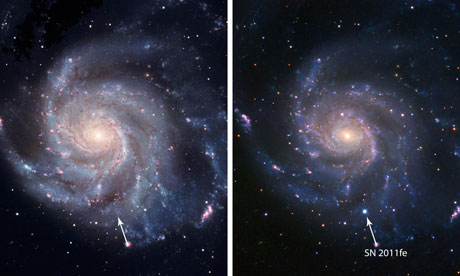Cosmic Distance Ladder
while observing the sky last night one question come in my
mind how astronomers calculates the distance to the stars,galaxies.i know that
they use the technique by transmitting and receiving the pulse from a radar but
for a very large distance the EM waves itself takes years to receive back the
signal pulse.
so,i come across the CDL. Cosmic Distance Ladder is series of
methods that astronomers use to determine the distance to celestial object.
There are different types of methods depending on location of the
celestial object.(below diagram)

for the solar system and nearby
stars we can use the radar and parallax techniques.but for very large distance
beyond the milkyway and above we can't use this techniques.because transmitting
a pulse to a very large distance and receiving it back takes a long time i.e
hours,months,years (cause speed of light is constant).
here i discuss Type Ia
Supernova Technique.
To find distances in space,
astronomers use objects called "standard candles." Standard candles
are objects that give a certain, known amount of light. Because astronomers
know how bright these objects truly are, they can measure their distance from
us by analyzing how dim they appear.
say you're standing on a street
evenly lined with lampposts. According to a formula known as the inverse
square law, the second streetlamp will look one-fourth as bright as the first
streetlamp, and the third streetlamp will look one-ninth as bright as the first
streetlamp, and so on. By judging the dimness of their light, you can easily
guess how far away the streetlamps are as they stretch into the distance.
so how can we put the standard
candle whose luminosity is known and look it from earth to calculate the
distance.well here comes supernova.
Supernovae are
extremely luminous and cause a burst of radiation that
often briefly outshines an entire galaxy, before fading from view over
several weeks or months. During this short interval a supernova can radiate as
much energy as the Sun is expected to emit over its entire life
span. The explosion expels much or all of a star's material.
below pictures shows the sn2011fe supernova
explosion in The Pinwheel Galaxy (also known as Messier
101, M101 or NGC 5457)

The luminosity differs
by the type of supernova but the typical visual

so we know the absolute
luminosity (standard candle like street lights in our analogy) and by using the
inverse square law we can find out the distance of the galaxies in which Type
Ia supernova occurred.
also watch this for parallax technique.
sources :- Wikipedia,Hubblesite,Skynet University Channel youtube